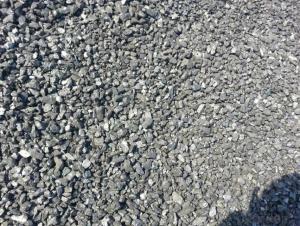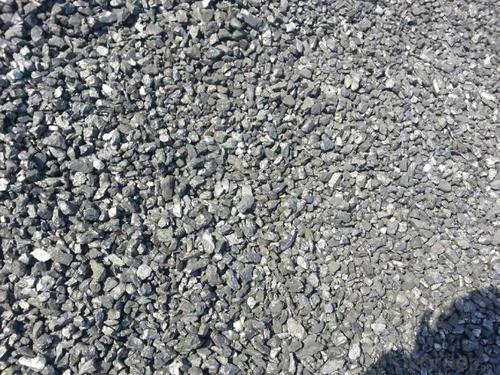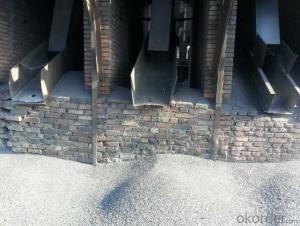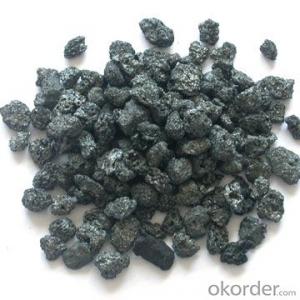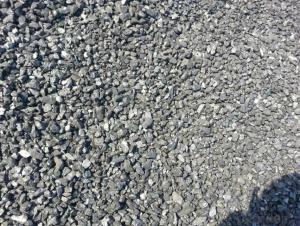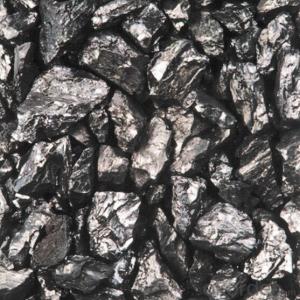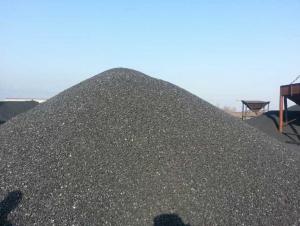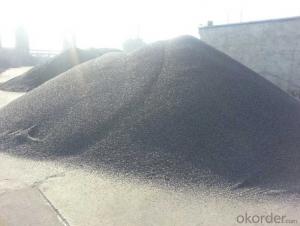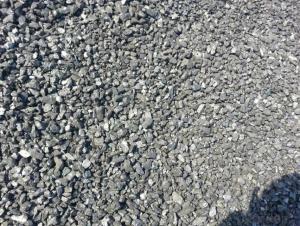FC90-95 Recarburizer -Low Sulphur and low P
- Loading Port:
- Tianjin
- Payment Terms:
- TT OR LC
- Min Order Qty:
- 20 m.t.
- Supply Capability:
- 3000 m.t./month
OKorder Service Pledge
OKorder Financial Service
You Might Also Like
Packaging & Delivery
25kgs/50kgs/1ton per bag or as buyer's request
Specifications
Calcined Anthracite
Fixed carbon: 90%-95%
S: 0.5% max
Size: 0-3. 3-5.3-15 or as request
It used the high quality anthracite as raw materials through high temperature calcined at over 2000 by the DC electric calciner with results in eliminating the moisture and volatile matter from anthracite efficiently, improving the density and the electric conductivity and strengthening the mechanical strength and anti-oxidation. It has good characteristics with low ash, low resistvity, low sulphur, high carbon and high density. It is the best material for high quality carbon products.
Advantage and competitive of caclined anthracite:
1. strong supply capability
2. fast transportation
3. lower and reasonable price for your reference
4.low sulphur, low ash
5.fixed carbon:95% -90%
6..sulphur:lower than 0.3%
General Specification of Calcined Anthracite:
| FC % | 95 | 94 | 93 | 92 | 90 |
| ASH % | 4 | 5 | 6 | 6.5 | 8.5 |
| V.M. % | 1 | 1 | 1 | 1.5 | 1.5 |
| S % | 0.3 | 0.3 | 0.3 | 0.35 | 0.35 |
| MOISTURE % | 0.5 | 0.5 | 0.5 | 0.5 | 0.5 |
Pictures

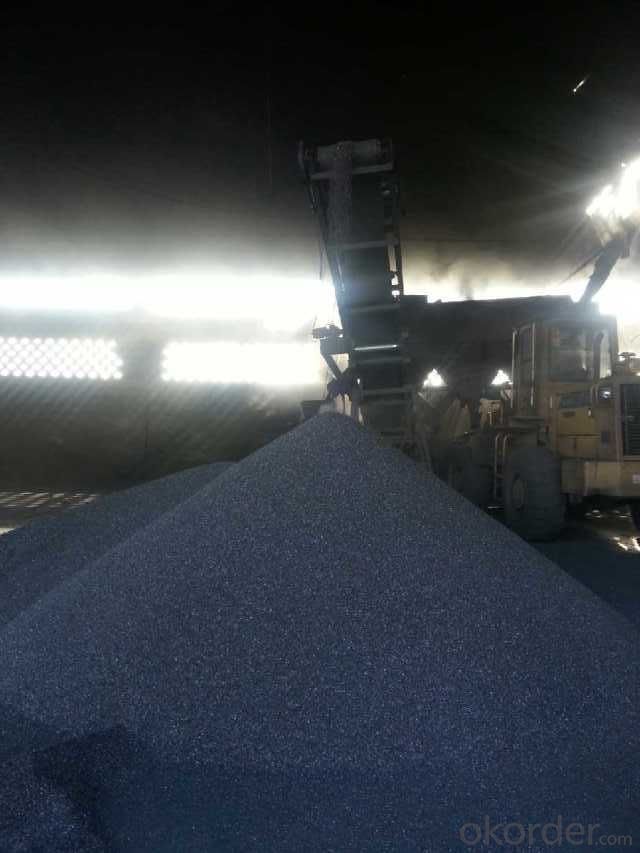
- Q: How does carbon impact biodiversity?
- Carbon impacts biodiversity in several ways. Firstly, carbon dioxide is a greenhouse gas that contributes to climate change, leading to shifts in temperature and precipitation patterns. These changes can disrupt ecosystems and alter habitats, affecting the distribution and survival of various species. Additionally, excess carbon in the atmosphere can lead to ocean acidification, which negatively affects marine biodiversity by harming coral reefs and other organisms reliant on calcium carbonate structures. Finally, deforestation and land-use changes associated with carbon emissions result in habitat loss, further reducing biodiversity. Overall, carbon emissions have significant and detrimental impacts on the delicate balance of ecosystems and the diversity of life on Earth.
- Q: How do you distinguish between alkaline and ordinary carbon cells?
- In addition, the alkaline cell logo has a unique "ALKALINE" content.Alkaline batteries weigh weight of the same type of battery, to return a lot of alkaline batteries than ordinary batteries. For example, the weight of alkaline cell 5 is about 24 grams, and the average dry battery weight of size 5 is about 18 grams.
- Q: Does anyone know what the definition of carbon storage is in ecology? Thank you
- If there is no clear definition of books on carbon storage in the understanding of ecology of the individual usually refers to the separation of gaseous carbon dioxide from the atmosphere, through the process of ecology carbon fixed, this process mainly refers to the plants convert carbon dioxide into carbohydrates.In addition, there is now another implication: carbon stripping technology will be used to collect carbon dioxide from human emissions into the air separation of the ground floor storage.
- Q: How does carbon contribute to the strength of alloys?
- Carbon contributes to the strength of alloys by forming interstitial solid solutions with metals, which increases the hardness and strength of the material. The carbon atoms occupy the spaces between the metal atoms, creating lattice distortions and enhancing the overall strength of the alloy. Additionally, carbon can also form compounds with metals, such as carbides, which further improve the hardness and wear resistance of alloys.
- Q: How does carbon dioxide contribute to global warming?
- The primary cause of global warming is the contribution of carbon dioxide (CO2) through the greenhouse effect. This phenomenon arises when specific gases in the Earth's atmosphere trap solar heat, preventing its escape into space. Although the greenhouse effect is a natural process that aids in preserving the Earth's temperature, human activities, particularly the combustion of fossil fuels, have significantly raised the concentration of CO2 in the atmosphere. When fossil fuels such as coal, oil, and natural gas are burned for energy generation, they release CO2 as a byproduct. This surplus of CO2 functions as a gas that traps heat, absorbing and subsequently emitting heat radiation that would otherwise dissipate into space. Consequently, the Earth's temperature is increasing, resulting in global warming. The repercussions of elevated global temperatures are extensive. They expedite the melting of polar ice caps and glaciers, leading to rising sea levels that jeopardize coastal regions and low-lying islands. Additionally, they disrupt weather patterns, resulting in more frequent and severe occurrences of heatwaves, droughts, hurricanes, and floods. Furthermore, global warming adversely affects ecosystems by causing shifts in habitats, loss of biodiversity, and detrimental impacts on plant and animal species. Reducing carbon dioxide emissions is of utmost importance in mitigating global warming. This objective can be accomplished through diverse approaches, such as transitioning to renewable energy sources, enhancing energy efficiency, investing in sustainable transportation, and implementing practices that foster reforestation and carbon sequestration. By undertaking these measures, we can decelerate the pace of global warming and alleviate its detrimental effects on both the planet and its inhabitants.
- Q: What is the atomic number of carbon?
- The atomic number of carbon is 6.
- Q: What are the impacts of carbon emissions on the stability of coral reefs?
- Carbon emissions have significant impacts on the stability of coral reefs. One of the main consequences of carbon emissions is ocean acidification, which occurs when carbon dioxide is absorbed by the ocean. This leads to a decrease in the pH level of the water, making it more acidic. Coral reefs are highly sensitive to changes in pH levels, and as the water becomes more acidic, it becomes more difficult for corals to build and maintain their calcium carbonate skeletons. The increased acidity of the water also affects the growth and survival of other organisms that form the foundation of coral reef ecosystems, such as algae and shellfish. These organisms play a crucial role in providing food and habitat for many species, including corals. As their populations decline due to acidification, the entire reef ecosystem becomes destabilized. Another impact of carbon emissions on coral reefs is ocean warming. Carbon dioxide acts as a greenhouse gas, trapping heat in the atmosphere and causing global temperatures to rise. This increase in temperature leads to coral bleaching, a process in which corals expel the symbiotic algae living within their tissues. The loss of these algae deprives corals of their main source of nutrition and gives them a bleached appearance. If the water temperatures remain high for an extended period, corals may die, resulting in the degradation of the reef structure. Furthermore, carbon emissions contribute to sea-level rise, which poses a threat to the stability of coral reefs. Rising sea levels increase the risk of coastal erosion and flooding, which can damage or destroy coral reef habitats. Additionally, increased storm intensity and frequency, a consequence of climate change, can physically damage coral reefs, making them more susceptible to disease and preventing their recovery. Overall, carbon emissions have a detrimental impact on the stability of coral reefs. Ocean acidification, coral bleaching, rising sea levels, and increased storm activity all work together to weaken and degrade these delicate ecosystems. It is crucial to reduce carbon emissions and take action to mitigate climate change in order to protect and preserve the health of coral reefs and the countless species that depend on them.
- Q: Carbon fiber refractory?
- 3, pre oxidized carbon fiber cloth, can withstand 200--300 degrees of high temperature
- Q: What are the main sources of carbon on Earth?
- The main sources of carbon on Earth are both natural and anthropogenic (caused by human activity). In terms of natural sources, carbon is present in the Earth's atmosphere in the form of carbon dioxide (CO2), which is released through natural processes such as volcanic eruptions, respiration by plants and animals, and the decay of organic matter. Carbon is also found in the Earth's lithosphere in the form of carbonate rocks, such as limestone and dolomite, which are formed from the shells and skeletons of marine organisms. Anthropogenic sources of carbon are primarily associated with the burning of fossil fuels, such as coal, oil, and natural gas, for energy production and transportation. When these fossil fuels are burned, carbon dioxide is released into the atmosphere, contributing to the greenhouse effect and climate change. Deforestation and land-use changes also release carbon stored in trees and vegetation into the atmosphere. Additionally, human activities like industrial processes, cement production, and waste management contribute to the emission of carbon dioxide and other greenhouse gases. These activities release carbon that has been locked away for millions of years, significantly altering the natural carbon cycle. Overall, while carbon is naturally present on Earth, human activities have significantly increased its release into the atmosphere, leading to concerns about climate change and the need for sustainable practices to reduce carbon emissions.
- Q: What are the different types of carbon-based composites?
- There exist various carbon-based composites, each possessing distinct properties and applications. Some commonly encountered types encompass carbon fiber reinforced polymers (CFRPs), carbon nanotube composites, and carbon fiber reinforced ceramics. Among these, CFRPs stand as the most renowned and extensively employed carbon-based composites. They feature carbon fibers embedded within a polymer matrix, such as epoxy resin. CFRPs exhibit a lightweight nature, coupled with exceptional strength and rigidity, rendering them ideal for industries where weight reduction and high strength prove essential, such as aerospace, automotive, and sporting goods. Carbon nanotube composites represent another category of carbon-based composites that have garnered substantial attention in recent years. Carbon nanotubes possess cylindrical structures comprising carbon atoms arranged in a hexagonal lattice. Upon incorporation into composite materials, they bolster mechanical, thermal, and electrical properties. Carbon nanotube composites hold potential applications across fields like electronics, energy storage, and structural materials. Carbon fiber reinforced ceramics combine the superior strength and rigidity of carbon fibers with the exceptional ability to resist high temperatures exhibited by ceramics. These composites widely find use in industries necessitating materials capable of withstanding extreme temperatures, such as aerospace, defense, and nuclear sectors. Carbon fiber reinforced ceramics offer an excellent balance encompassing strength, thermal stability, and low weight. Additional types of carbon-based composites encompass carbon fiber reinforced metals, wherein carbon fibers are embedded within a metal matrix, and graphene composites, which incorporate graphene sheets into a polymer or metal matrix. These composites offer distinct properties like high electrical conductivity, thermal stability, and mechanical strength, unveiling possibilities for applications in areas like electronics, energy storage, and structural materials. On the whole, carbon-based composites present a wide array of properties and applications, rendering them indispensable materials within various industries requiring lightweight, strong, and durable substances.
Send your message to us
FC90-95 Recarburizer -Low Sulphur and low P
- Loading Port:
- Tianjin
- Payment Terms:
- TT OR LC
- Min Order Qty:
- 20 m.t.
- Supply Capability:
- 3000 m.t./month
OKorder Service Pledge
OKorder Financial Service
Similar products
Hot products
Hot Searches
Related keywords
